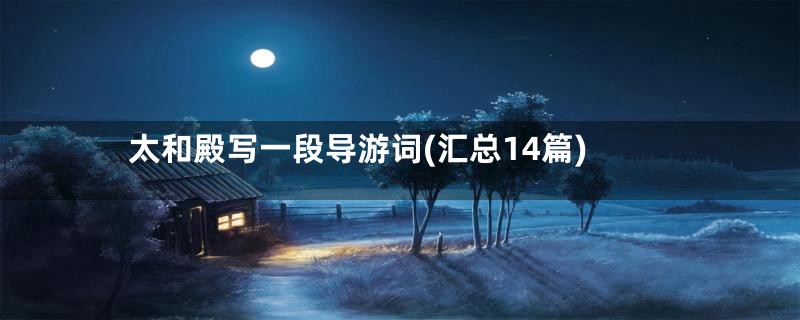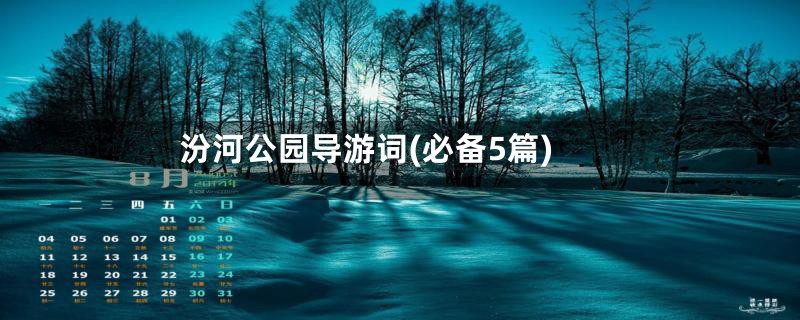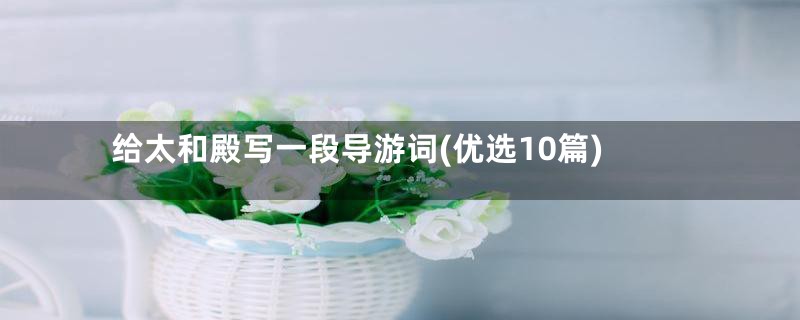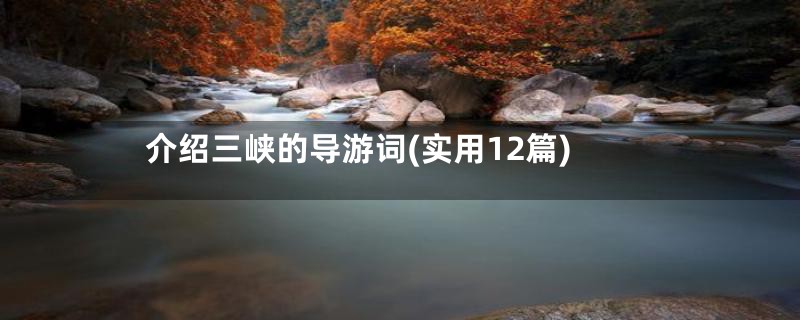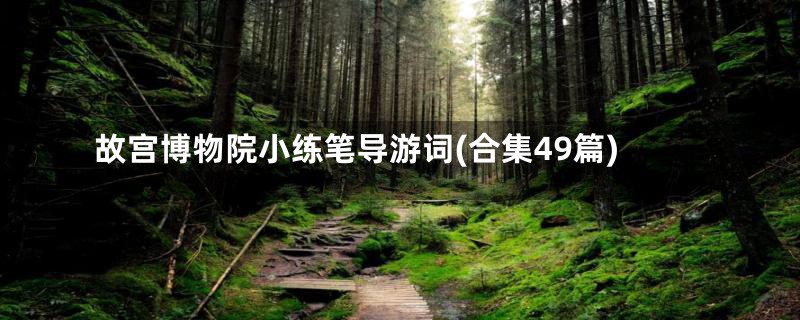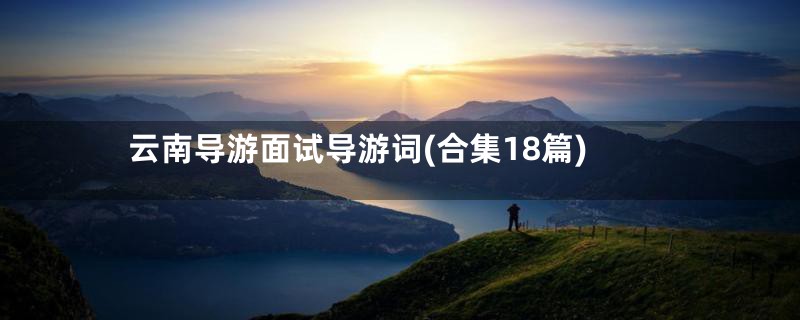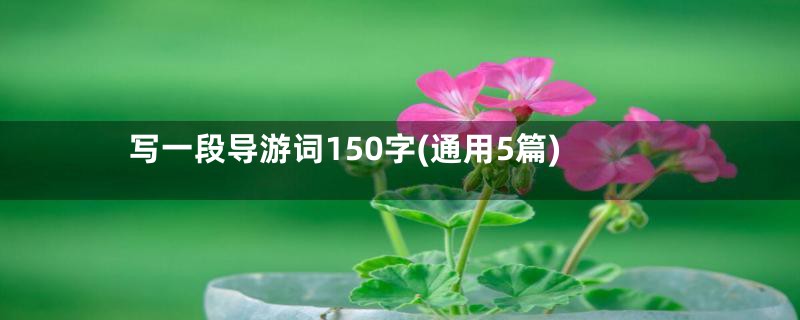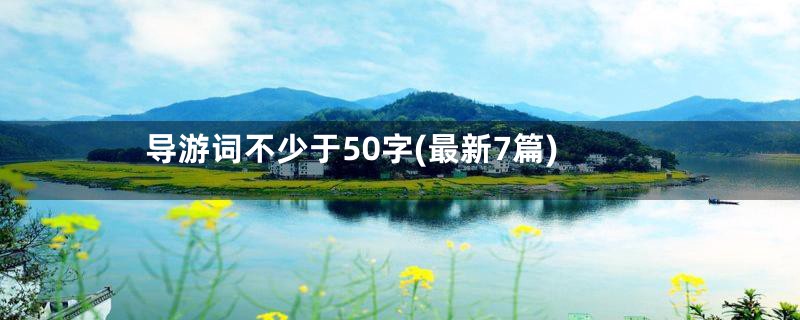明十三陵导游词简短 第1篇
各位朋友,请往右侧的窗外看,这是十三陵陵区的标志性建筑物——石牌坊,它是我国保存至今的最大的石牌坊,共有五门六柱十一楼,建于公元1540年,至今已有四百六十多年历史了。
现在请大家往前看,前方有一个大门,门开三洞,这便是明十三陵陵区的正门——大宫门。因其颜色为红色,故又称之为大红门。在大宫门的左右各立有一座皇帝下马碑,上书“官员人等至此下马”,在古代皇帝到这来祭陵,至此也必须下马。原来在大宫门的两侧连有40公里长的围墙,设为禁区,重兵把守。其实就是一座为*皇帝而设的“紫禁城”。明朝规定,每年大祭三次,小祭四次。皇帝每次祭陵便在大宫门前下马进入陵区。
在大宫门之后依次是碑亭、石象生、棂星门,这条路被称为神路,下面我把神路上的建筑向各位做一简介。大家请看前面的碑亭,里面是长陵的神功圣德碑。正面是碑文,列述永乐皇帝的功绩,碑的背面是清乾隆皇帝写的《哀明陵三十韵》,碑东侧是清政府修明陵的花费记录,西侧是清朝嘉庆皇帝论述明亡的原因。
在碑亭之后便是整齐地排列于神路两侧的石像生,何为石像生呢?其实就是些石人、石兽等,即为象征生命的石雕,它们将为*的帝王们在另一个世界提供服务。十三陵的神路上有石兽24只,包括狮子、獬豸、骆驼、麒麟、马和大象,每种兽4只,两立两卧。此外还有石人12个,即文臣、武将、勋臣各4人。
在神路的尽头是棂星门,俗称龙凤门,当地人又称其为火焰牌坊,此处意为“天门”,即皇帝皇后等人的棺樽通过此门后,灵魂便升入了天堂。
我们马上就到了,请大家收拾一下随身物品,带好照像机,我们准备参观十三陵之首——长陵。
明十三陵导游词简短 第2篇
各位朋友,现在我为大家介绍一下定陵,定陵是十三陵中唯一打开地宫的陵,它是明朝第十三位皇帝朱翊钧和他的两位皇孝端和孝靖的合葬陵,位于天寿山的大峪山前,建成于公元1590年。
朱翊钧年号万历,意思是要做一万年的皇帝,虽然没有实现,但也创下了明朝皇帝的一项记录,即在位年数最长的皇帝。万历皇帝10岁继位,22岁就开始为自己修陵,建地宫。整个工程历时六年,耗银八百多万两。他在位48年,几乎不理朝政,终日沉缅于后宫,他好饮酒,经常酒醉杀人,死后葬在了定陵。
万历皇帝有两个皇后,孝端皇后和孝靖皇后。孝靖皇后死时只是一个贵妃,按明朝规定,皇贵妃死后不能入地宫,于是葬在了其它地方。皇太子继位后,追封孝靖为皇太后。孝端皇后和万历皇帝去世后,有将孝靖皇后迁葬到地宫。所以地宫中葬有一帝二后。定陵的地下宫殿于1957年被打开,出土文物3000余件,举世轰动。
目前,定陵已成为全国重点风景名胜区,4A级景点,每天都有来自世界各地的旅游者前来参观。
整个陵园原来由陵门、陵恩门、陵恩殿、明楼、宝城、宝顶及明楼前的左右配殿组成。历经近520xx年的苍桑,原来的陵恩门及陵恩殿已毁,仅存基座。由于定陵的明楼为石质,不怕火烧、故至今保存完好。现在我们先来看一看陵恩门及陵恩殿遗址。
看过_
明十三陵导游词简短 第3篇
明十三陵,世界文化遗产,全国重点文物保护单位,国家重点风景名胜区,国家AAAAA级旅游景区。
明十三陵坐落于北京市昌平区天寿山麓,总面积一百二十余平方公里,距离天安门约五十公里。自永乐七年(1409)五月始作长陵,到明朝最后一帝崇祯葬入思陵止,其间230多年,先后修建了十三座皇帝陵墓、七座妃子墓、一座太监墓。共埋葬了十三位皇帝、二十三位皇后、二位太子、三十余名妃嫔、两位太监。截止20xx年,已开放景点有长陵、定陵、昭陵、神路。
十三陵地处东、西、北三面环山的小盆地之中,陵区周围群山环抱,中部为平原,陵前有小河曲折蜿蜒,山明水秀,景色宜人。这里自永乐七年(1409)五月始作长陵,到明朝最后一帝崇祯葬入思陵止,其间230多年,先后修建了十三座皇帝陵墓、七座妃子墓、一座太监墓。共埋葬了十三位皇帝、二十三位皇后、二位太子、三十余名妃嫔、一位太监。
十三座皇陵均依山而筑,分别建在东、西、北三面的山麓上,形成了体系完整、规模宏大、气势磅礴的陵寝建筑群。明代术士认为,这里是_风水_胜境,绝佳_吉壤_。因此被明朝选为营建皇陵的_万年寿域_。该陵园建于1409~1644年,距今已有300~500多年历史。陵区占地面积达40平方公里,是中国乃至世界现存规模最大、帝后陵寝最多的一处皇陵建筑群。明代时,于途中的沙河镇北,建有七孔石造_朝宗桥_。在镇东,则筑有壮丽的_巩华城_。该城原为嘉靖皇帝祭陵时中途休息的行宫,现仅存遗址。
明十三陵导游词简短 第4篇
明十三陵,坐落于天寿山麓,距离北京约五十公里。陵区周围群山环抱,中部为平原,陵前有小河曲折蜿蜒,山明水秀,景色宜人。十三座皇陵均依山而筑,分别建在东、西、北三面的山麓上,形成了体系完整、规模宏大、气势磅礴的陵寝建筑群。十三陵建于1420xx年,距今已有300—600多年历史。陵区占地面积达40平方公里,是中国乃至世界现存规模最大、帝后陵寝最多的一处皇陵建筑群。
明长陵,位于天寿山主峰南麓,是明朝第三位皇帝成祖文皇帝朱棣(年号永乐)和皇后徐氏的合葬陵寝。在十三陵中建筑规模*大,营建时间*早,地面建筑也保存得很完好。它是十三陵中的祖陵,也是陵区内主要的旅游景点之一。
长陵的陵宫建筑,占地约12万平方米。其平面布局呈前方后圆形状。其前面的方形部分,由前后相连的三进院落组成。*进院落,前设陵门一座。其制为单檐歇山顶的宫门式建筑,面阔显五间,檐下额枋、飞子、檐椽及单昂三踩式斗拱均系琉璃构件;其下辟有三个红券门。陵门之前建有月台,左右建有随墙式角门(已拆除并封塞)。
十三陵院内,北面正中位置建有高大巍峨的祾恩殿。这座大殿在明清两代,是用于供奉帝后神牌(牌位)和举行上陵祭祀活动的地方。
明定陵,是明代第十三帝神宗显皇帝朱翊钧(年号万历)的陵墓。这里还葬有他的两个皇后。该陵坐落在大峪山下,位于长陵西南方,建于1584~1590年(万历十二年至万历十八年)。它是十三陵中*一座被发掘了的陵墓。定陵地宫可供游人参观。新中国成立后,为进行历史科学研究,试掘了定陵。墓中有各种珍贵物品三千余件。明定陵地面建筑的总布局呈前方后圆形,含有中国古代哲学观念“天圆地方”的象征意义。
定陵是十三陵中三座大陵园之一。地面建筑共占18万平方米,前有宽阔院落三进,后有高大宝城一座。陵正门前方是三卒汉白玉石桥。过了桥是高大的碑亭。
地下玄宫由前、中、后、左、右五座高大宽敞的殿室联结而成,总面积1195平方米。其中前殿和左、右配殿内没有任何陈 设,中殿后部放有三个汉白玉石雕刻的宝座,每个宝座前设有一套黄色琉璃五供和一口青花云龙大瓷缸,后殿内棺床上放置皇 帝、皇后的棺椁,在其周围还放有26支红漆木箱,仪仗、铭旌及玉石等。地下玄宫出土了3000余件珍贵文物。
神路是明十三陵的*个景点,由石牌坊,大红门,碑楼,石像生,龙凤门等组成。石牌坊为陵区前的*座建筑物,建于1540年(嘉靖十九年)。牌坊结构为五楹、六柱、十一楼,全部用汉白玉雕砌,在额枋和柱石的上下,刻有龙、云图纹及麒麟、狮子等浮雕。
十三陵神道,即长陵神道,是长陵陵寝建筑的前导部分。总长约公里。明朝时由南而北,依次建有石牌坊、三空桥、大红门、神功圣德碑亭、石像生、棂星门、南五空桥、七空桥、北五空桥等系列神道墓仪设施及桥涵建筑。
从大红门左右两侧延伸至龙山、虎山两山之巅,然后再向东西两侧蜿蜒而去。大红门处于高岗之上,中门正对天寿山主峰,左右又衬以龙山和虎山,气势非凡。
明昭陵,位于大峪山东麓,是明朝第十二帝穆宗庄皇帝朱载垕(年号隆庆)及其三位皇后的合葬陵寝。
昭陵是目前十三陵中*座大规模复原修葺的陵园,也是陵区正式开放的旅游景点之一。昭陵陵园建筑面积为35000平方米,现存有完整的祾恩门、祾恩殿及其东西配殿,和方城、明楼、宝顶等。这里埋葬有明朝第十二帝穆宗朱载垕和他的三位皇后。
银山塔林引位于昌平区城北30公里处,是_公布的中国重点文物保护单位,也是十三陵特区办事处主要的风景名胜区。银山,因秋去冬来,瑞雪纷飞,山岩银装素裹,冰雪层积而得名,又因山岩陡峭,岩壁色黑如铁,称为“铁壁”,合称“银山铁壁”。为明清时期“燕京八景”之一。
明十三陵导游词简短 第5篇
THE MING TOMBS
The Ming Tombs are 40 kilometers north of Beijing City on the southern slopes of Tianshou Mountain. They are the burial grounds of 13 Ming Dynasty emperors. In July 20xx the site was designated a world cultural heritage site by UNESCO.
Empress Xu died in the 5th year of Yongle (1407). Zhu Di sent
Zhao Hong, secretary of the Ministry of Rites and a geomancer----Liao Junqing along with many others to Beijing in search of an auspicious place for the tombs. It is said that this group of people first selected the area of Tu Jia Ying, which means slaughter-house, and as such, it couldn't be used as the burial ground. Next they selected the foot of Yangshan Mountain, Changping. However, since the surname of the emperor (Zhu) is a homophone for pig and because a village named 'wolf mouth ravine' was located there, they decided against using that area. Later, they found Yan-jiatai west of Beijing. Again, since 'Yanjia' was the homonym of the death of the emperor, it was also deemed unsuitable. It was not until the 7th year of Yongle (1409), that they finally chose the present Heavenly Longevity Mountain as their cemetery grounds.
The whole area covers 40 square kilometers. It has mountains to its east, west and north, and Dragon Mountain and Tiger Mountain are on either side of its southern entrance. The 13 tombs go from north to south. They are arranged in the manner of the Imperial Palace, with the administration area in the front and living quarters in the rear. In front of the tombs are divine passes, stone archways and steel towers. The Precious City and Ming Tower stand over the Underground Palace.
There were 16 emperors during the Ming Dynasty. Buried in the Ming tombs, are 13 Ming emperors and 23 empresses, as well as many concubines, princes, princesses and maids. The other 3 emperors, Emperor Zhu Yuanzhang, Zhu Yunwen and Zhu Qiyu are buried in other locations.
The founder of the Ming Dynasty, Zhu Yuanzhang, established his capital in present day Nanjing where he was buried after his death. His tomb is called Xiaoling (Tomb of Filial Piety).
The body of the second emperor of the Ming, Zhu Yunwen, is missing. Some said that he died in a fire, while others said that he went to a temple and became a monk. There is no final conclusion yet.
The seventh Ming Emperor Zhu Qiyu, was buried as a prince by his elder brother Zhu Qizhen at Jinshankou, a western suburb of Beijing, because in the Tumubao Upheaval, Emperor Zhu Qizhen became a captive and the younger brother of Zhu Qizhen. Zhu Qiyu was chosen as the new emperor, but later Zhu Qizhen was back and proclaimed his re-enthronement in the Seizing Gate Upheaval.
The Memorial Arch was built in the 19th year of Jiajing (1540) as a symbol of the Ming Tombs. It is 14 meters high and 28. 86 meters wide, and has 5 arches supported by 6 pillars with beautiful bas-relief carvings of lions, dragons and lotus flowers. The Memorial Arch is the biggest and the most exquisite stone arch preserved in the country today. The major designs of dragon and cloud decorations reflect the character of imperial architecture. In addition, it also demonstrates the skillful artistry of the Ming craftsmen.
The Big Palace Gate is the front gate of the Ming Tombs, and is more commonly known as Big Red Gate. Facing south, there are three arch entrances to the gate, the main inlet to the Ming Tombs. Flanking the gate are two stone tablets, inscribed with orders for the emperor, officials and other people to dismount, before entering into the tomb area. If they did not obey, they would be punished for their disrespect. The rules governing the Ming Tombs in the Ming Dynasty, stipulate that one who sneaks into the tomb area to pick firewood and break twigs would be flogged. Those who came to fetch dirt and stone would be beheaded. Those who entered arbitrarily into the tomb area would be flogged a hundred times.
The Tablet House was built in the 10th year of Xuande (1435), and stands about 10 meters high with two tiers of eaves. A huge tablet stands in the middle of the Tablet House. The front side bears an inscription by Emperor Renzong for Chengzu. The reverse side is a poem by Qing Emperor Qianlong recording in detail the conditions of the broken Changling, Yongling, Dingling and Xiling. On the east side is the record of expenditures for repairing the Ming Tombs by the Qing government. On the west side is an epitaph by Qing Emperor Jiaqing. It was written in the 9th year of Jiaqing (1804) describing the cause of the fall of the Ming Dynasty.
On the north side of the Tablet House, stands a group of stone carvings (36 in all). Behind the house, there are two stone pillars. Beyond the pillars are stone animals and other statues. Lions, Xie Zhi, camels, elephants, and Qi Lin horses .All of the animals are in two pairs. Two stand, while the other two kneel. It is followed by the statues of military officers, civil officials and officials of merit, four in each group. These stone animals and statues were made in the 10th year of Xuande (1435). They reflect the imperial power when he was alive and the imperial dignity after he was deceased. The animals and statues were created using whole blocks of stone weighing a couple of tons and each was delicately and masterfully carved.
Here stands Ling Xing Gate, also known as the unique Dragon and Phoenix Gate, with the meaning of the Gate of Heaven. The gate is pierced with six door leaves, attached to three archways. The top of the central section of the three archways is decorated with flames and precious pearl, so it is also known as the Flame Archway. To the north of the Dragon and Phoenix Gate there lays a seven-arch marble bridge, leading to the gate of Changling. To the east of the seven-arch bridge stands an old five-arch bridge, which was the original site of the seven-arch bridge.
Actually we are standing on the axle line of the Ming Tombs, otherwise known as the Sacred Way or the Tomb path. We passed the Memorial Arch, the Big Palace Gate, the Tablet House, Sacred Way, stone animals and statues, and Ling Xing Gate. This seven-kilometer long sacred pathway leads from south to north, all the way to the Gate of Changling.
Now, we are moving to Chang Ling. Changling is the first tomb built in the Ming Tombs area, covering 10 hectares and containing Emperor Zhu Di and his empress Xu.
Zhu Di (Chengzu) of the Ming Dynasty was the fourth son of the first Emperor Zhu Yuanzhang, born in 1360. Zhu Di was conferred the title of the prince of Yan in the 3rd year of Hongwu (1370). He was appointed at Beiping. After the death of Zhu Yuanzhang (the first Ming Emperor), Zhu Di used the pretext of eliminating evil officials at the side of Emperor Jianwen to lead an army expedition down south to Nanjing. He seized the throne in the 4th year of Jianwen (1402) and ascended the throne in June inside the Hall of Ancestral Worship in Nanjing. Zhu Di was an emperor of outstanding accomplishment in the Ming Dynasty. As soon as he became the prince of Yan, he led the generals out to battle. He had great achievements in calming down the north. After he took over his nephew's power and became the emperor, he still went out to battle throughout the country and consolidated the rule of the Ming Dynasty. He made the important decision to move the capital to Beijing. During the rule of Zhu Di, magnificent developments were made in the economy, culture and in diplomacy. In terms of culture, Zhu Di successively sent Grand Academician Xie Jin, Yan Guangxiao and others to compile the Yongle encyclopedia. The book has become the largest book ever complied in Chinese history. For expanding external exchanges and trade, Zhu Di selected eunuch Zheng He to lead a large fleet filled with precious gold, silver, silk and satins to sail to southeast Asia and Africa seven times in the early years of Yongle.
Empress Xu was buried together with Emperor Zhu Di in Changling. Empress Xushi was the eldest daughter of Xu Da who was one of the founding fathers of the Ming Dynasty. Throughout her lifespan, Xu Shi complied 20 articles of internal lectures and a book advising to be good, so as to cultivate people's minds. She was the very first one to be buried in Changling and in the Ming Tomb area.
The Hall of Eminent Favor in Changling is the best preserved among the thirteen tombs. It is a valuable relic of ancient China's wooden structures. It is nine rooms wide and five rooms long, a hall size rarely seen in China. The roof is made of top-class double eaves and there are multiple rooms covered with yellow glazed tiles. The hall is supported by 60 thick Nanmu pillars, the middle four in the hall are the thickest, the diameter of each one can reach over one meter. It is known as the best Nanmu (phoebe) hall in the country.
Now we are going to Dinging. Dingling is located at the east foot of Dayu Mountain. Buried here are the 13th Ming Emperor Wanli (Zhu Yijun) and his two empresses Xiaoduan and Xiaojing. Zhu Yijun was the longest on the throne of the Ming Emperors. (He was emperor for 48 years). He was the greediest and laziest emperor in the Ming Dynasty. Zhu Yijun ascended the throne at the age of 9. After he came to power, he was supported by the chief minister Zhang Juzheng. At this time, various aspects of society gained development.
Later ,Zhang Juzheng died of illness. Not long after Wanli managed state affairs on his own, he used the chance to select the location for his tomb site when he went to pay homage to the ancestors' tombs. He spent eight million taels of silver (250,000 kilos of silver) and six years to build a high quality tomb Dingling. After the Dingling was completed, Zhu Yijun personally went to inspect it, and felt very satisfied with the result. He went so far as to hold a grand banquet in the Underground Palace, which was unheard of in history.
Zhu Yijun was a typical muddle-headed emperor. Reflecting on his reign, he did not pay attention to state affairs for 28 out of his 48 year rule. The state organ was effectively semi-paralyzed during his reign. Later generations commented that the fall of the Ming dynasty was caused by this emperor.
Zhu Yijun had two empresses. Empress Xiaojing was originally a maid of Wanli's mother Cisheng. Later she gave birth to a son of the emperor. That son was the one-month emperor Guangzong (Zhu Changluo). She died of illness 9 years earlier than Shenzong died. She was buried as a concubine at Pinggangdi, around the east pit, at the Heavenly Longevity Mount. After Xiaojing was conferred the title of “grandmother of the emperor”, her body was moved to the Underground Palace of Dingling, and buried together with Emperor Wanli and Empress Xiaoduan on the same day. Xiaoduan was conferred the title of empress, but she could not give birth to either a son or a daughter to the emperor. Xiaoduan died of illness. A hundred days later, Emperor Wanli (Zhu Yijun) died too. Empress Xiaoduan, Emperor Wanli, and Empress Xiaojing were buried together in the Underground Palace.
The tablet in front of Dingling has no words on it. It is called the wordless tablet. There is a pair of coiling dragons along the top and a pattern of sea waves carved on the bottom. Its base is composed of a tortoise (Bixi). It is said that the dragon has nine sons. In twelve of the Ming Tombs, excluding Changling, all the tablets are wordless. Originally there were no tablet houses in front of the Tombs, but later the tablet houses and steeles of the first six tombs were completed. But the emperor Jiajing at the time indulged in drinking, lust and searching for longevity pills, so he had no time to pay attention on the inscriptions. Consequently the six tablets are wordless. And in keeping with this tradition, that’s why the tablets later on are also blank.
Now we are arriving at The Gate of Eminent Favor and the Hall of Eminent Favor of Dingling, The Hall of Eminent Favor is also called Hall of Enjoyment. It was the place where the emperor and his entourage held grand sacrificial rites. They were mostly destroyed when the Qing soldiers came. And they were destroyed again later, so now only the ruins remain.
Moving on, this is the exhibition rooms that were built after the excavation of the Underground Palace. The exhibition explains in detail the history of the tomb master and introduces the tomb excavation process. The exhibition rooms are divided into two parts, the south and the north. In the south room, on display are the sacrificial objects of Emperor Wanli unearthed from the Underground Palace. In the north room, on display are the sacrificial items of the two empresses. All of then are fancy and invaluable.
Now we arrive at The Soul Tower, this is the symbol of the tomb. It is a stone structure with colorful painted decorations. The Soul Tower and the Precious citadel of Dingling have never been damaged seriously. The Soul Tower is the best preserved architecture above the ground of Dingling. On top of the yellow, glazed tiled roof of the Soul Tower sits a big stone tablet. Two Chinese characters----Dingling, are carved on the tablet. Inside the Soul Tower, on top of another stone tablet, there are two big characters----'the Great Ming' written in seal characters. On the body of the tablet, seven Chinese characters-----'Tomb of Emperor Shenzong Xian' are carved. The Soul Tower is connected with the Precious Citadel. The Precious Citadel is a large round wall built with bricks. The Precious Citadel wall is m high, and lower part is thick while the upper part is thin. The round wall's perimeter is over 800 meters, and inside the wall is a large artificial mound, the emperor's tomb mound, known as Precious Top.
Dingling is the only Ming Tomb to be excavated. Formal excavation work started in May 1956 and ended in 1958. First, the working personnel discovered an exposed gateway at the side wall to the southwest of the Precious Citadel of Dingling. So they dug the first tunnel facing the position of the gateway. At the bottom of the tunnel, they discovered a tunnel made of bricks. Three months later, along the direction of the tunnel, to the west of the Soul Tower, they dug the second tunnel. During the digging, they encountered with a stone tablet which inscribed the words ' from here 48. 8m forward and 10. 7m downward lies the precious wall'. Therefore it gave the correct direction of opening up the Underground Palace.
According to the direction of the stone tablet, after digging the third tunnel, they found a stone tunnel. At last they got to the precious wall. Thus they opened the precious wall with a square stone room. To the west end of the room, lay two marble doors. The working personnel used a wire and wood plank to remove the ' self-acting' stone bar, which was against the back of the door. With this method, they opened the entrance of the Underground Palace.
The palace has no beam which was built according to the principles of geomancy Altogether there are five chambers. The chambers are separated by seven marble doors. The Underground Palace is 27 meters deep, covering an area of 1,195 square meters. There is a same structure stone door in between the front, middle and rear chambers. The door is made of marble. The biggest marble door is 3. 3 meters high, meters wide, 4 tons in weight. It looks heavy, but it is reasonably designed. The pivot of the stone door is inclined to the door axle, so the door is easy to open and close. On top of the door is a lintel (made of bronze) tube weighing about 10 tons to prevent the door from falling. Carved on the front of the marble door are 9 rows of 81 knobs and strange animals with rings in their mouths. Located on the reverse side, opposite the animals, is a protruding section that holds the door's 'self-acting' stone bar.
The front and middle chambers are 7. 2 meters high and 6 meters wide. The floor is covered with gold bricks. According to records, the gold bricks are smooth and durable. The more you polish them, the brighter they become. There are no decorations in the front and two annex chambers. In the middle chamber, there are three marble thrones for Emperor Wanli and his two Empresses, known as the precious thrones. In the front of the thrones, there are five yellow glazed offerings and one blue-and-white porcelain jar of Jiajing Year's style with a cloud-and-dragon design. It is about meters in diameter. Originally there was sesame oil in the jar. On the surface of the oil was a copper tube with a wick inside. It is called the 'everlasting lamp'. Due to the lack of oxygen, the light went out so the oil had not been used all.
The rear chamber is the biggest of the three. It is meters high, 31 meters long, meters wide, the floor is paved with polished stones. In the rear chamber, there is a coffin platform edged with white marble. Placed on the platform are the coffins of Emperor Wanli and his two Empresses as well as 26 vermilion boxes filled with funeral objects.
In the middle of the coffin platform, there is a rectangular hole filled with soil called Gold Well. Putting jade stone around the coffin or inside the coffin or in the mouth of the deceased is called being ' buried with jade. ' Ancient people believed Gold Well was the pit of geomancy. It could prevent the body from decay for a long time. Being 'buried with jade' on a Gold Well was the highest standard of entombment one could receive in the feudal era.
Originally the empress's coffin should have been placed in the rear chamber. Then why were the coffins of the two empresses also in the same chamber as the emperor's? In 1620, first empress Xiaoduan died in April, then in July Emperor Wanli also died. After that, the son of Zhu Changluo died 29 days after his succession. In only a few months, two emperors and one empress had died in succession. In addition they had removed Empress Xiaojing's coffin to Dingling. All the burdens of the funeral burials fell on the just enthroned Emperor Zhu Youjian. The preparation work was done in a hurried fashion (this was clearly recorded in historical documents). The rainy season had already arrived before the funeral could occur and the passage leading to the empress' annex chamber may not have been convenient to open. So the coffins of the emperor, empresses all entered the Underground Palace through the front entrance. After the coffins entered the Underground Palace, since the passage to the annex chambers were narrow, the coffins of the empresses would not fit through it. So they had to put all the three coffins together into the rear chamber.
Now please follow me out of the underground palace. And our tour for today is completed. I hope you have found our time together informative and enjoyable. We now have half an hour for a rest, and then we will get together here at 4:00pm. Thank you.
明十三陵导游词简短 第6篇
Chers amis,
Bonjour tout le monde! Avec le démarrage de la voiture, notre activitétouristique d'aujourd'hui a officiellement commencé.Je suis très heureux d'avoirl'occasion de vous accompagner aujourd'hui pour visiter les tombes.
Les tombes Ming mondialement célèbres sont situées au pied des montagnesYanshan dans le district de Changping à un rayon de 40 kilomètrescarrés, 13 empereurs, 23 impératrices et de nombreuses concubines, princesses,princesses et servantes funéraires de la dynastie Ming sont enterré parlantde cela, un ami familier avec l'histoire de la Chine peut se demander: il y a 16empereurs dans la dynastie Ming, pourquoi seulement 13 sont enterrés ici? Pourrépondre à cette question, il est temps de revenir sur l'histoire de la dynastieMing.
L'empereur fondateur de la dynastie Ming, Zhu Yuanzhang, a construit laville à Nanjing aujourd'hui. Après sa mort, il a été enterré dans le _mausoléeMing Xiao_ de Zhongshan, que le Prince Zhu Biao est mort t?t, il aété transmis à Zhu Yunyan, le petit - fils a?né.L'empereur Yongle Zhu Di a prisle tr?ne de son neveu Zhu nom de l'entrée à Pékin pour éliminer lestra?tres, Zhu Di a envoyé des troupes vers le 'empereur Jianwen Zhu Yunkangn'a pas été retrouvé dans cette disent qu'un feu dans lePalais a été br?lé à mort, d'autres disent que le moine est devenu moine, c'esttoujours un cas en suspens dans l'histoire de la dynastie Ming, donc il n'y apas de mausolé qiyu, le septième empereur de la dynastie Ming, a étécapturé par son frère a?né, l'empereur Yingzong Zhu qizhen, lors de latransformation du ch?teau de génie civil. Il ne pouvait pas être un empereursans propriétaire en un jour.
Plus tard, l'empereur Yingzong a été remis en liberté et a organisé un_changement de porte_ sous la planification de son c?ur, le parti Yingzong a étérestauré et est devenu ès la mort de Zhu qiyu, l'empereur Yingzongne l'a pas reconnu comme empereur. Il a détruit le mausolée que Zhu qiyu avaitconstruit dans la région des tombes Ming et l'a enterré comme _Prince_ au colJinshan dans la banlieue ouest de Pé, les 16 Empereurs de la dynastieMing, dont deux ont été enterrés ailleurs, l'un n'a pas été retrouvé, et les 13autres ont été enterrés ici, de sorte qu'ils ont été collectivement appelés_tombes Ming_.Les tombes Ming sont l'un des b?timents les plus préservés et lesplus enterrés au monde.
Les tombes sont construites dans une belle région montagneuse, à environ 50km de la capitale, et la superficie totale des tombes est d'environ 40kilomètres carré tombes des treize tombes ont été choisies et construitesselon le principe du Feng Shui, parce que les anciens Chinois ont mis l'accentsur le Feng Shui, que ce soit dans la construction de maisons ou de 'empereur est plus prétentieux, non seulement pour vivre une vie luxueuse, maisaussi pour continuer à profiter après la mort, de sorte que le choix du mausoléeest crucial.
Lors du choix du site du mausolée, il est nécessaire de choisir un bonendroit avec des montagnes et de l'eau, un bon environnement naturel et un ?vent de réservoir de gaz ?.Et les tombes sont un bon endroit: l'ensemble dumausolée est, Ouest, Nord entouré de montagnes, et au sud il y a des montagnesdragon et tigre à gauche et à droite, formant une porte naturelle, juste enaccord avec fengshui _dragon vert gauche, tigre blanc droit_ milieu,comme une grande cour, il y a la rivière Wenyu qui serpente du Nord - Ouest auSud - est dans la région du mausolée, formant un bassin dans la région dumausolé la région du mausolée prend le mausolée Changling comme pointclé, la ligne du Grand Palais - le mausolée Changling comme axe central, et lamontagne Tianshou comme ville au 'eau sur le dos de la montagne etl'accumulation de gaz sont en effet un endroit idéal pour les tombes.
La raison pour laquelle l'empereur Yongle a choisi la montagne Tianshouactuelle a également subi de nombreux ès la _bataille de Jingnan_, ZhuDi est devenu empereur à Nanjing. ? cette époque, il a décidé de déménager sacapitale à Pékin pour consolider le pouvoir la cinquième année deYongle, c'est - à - dire 1407, l'impératrice Xu de Zhu Di est morte. ? cetteépoque, afin d'exprimer sa détermination à déménager la capitale de Pékin, ZhuDi a envoyé le Ministre de l'étiquette et le Sorcier Feng Shui Liao junqing àPékin pour choisir le _sol favorable_.On dit que plusieurs endroits ont étéchoisis.
Tout d'abord, il a choisi le camp de boucherie à l'extérieur de la bouche,mais parce que l'empereur s'appelait Zhu, il avait la même prononciation que_cochon_, et _Boucher_ était le sens de l'abattage, le cochon dans le boucherdoit mourir sans aucun doute, de sorte que les tabous ne peuvent pas êtreutilisé autre endroit a été choisi au pied de la montagne Yangshan dans leSud - ouest de Changping, où les porcs et les moutons s', mais il y a un village derrière la montagne appelé _Wolf eryu_.Il est plus dangereux et inutile d'avoir des loups près des tard,j'ai choisi yanjiatai à l'ouest de Pékin, mais _yanjia_ et _Yan Jia_ homonymes,aussi malchanceux.
Parce que la mort de l'empereur antique, en plus d'appeler _Drive - in_,aussi appelé _Yan Jia_.Bien que le paysage du temple tanzhe soit bon, lesmontagnes sont profondes et étroites, ce qui n'est pas propice au développementdes générations futures et ne convient pas à l' n'est que plustard que nous sommes arrivés à la montagne Mountain à cetteépoque s'appelait Loess Mountain, l'empereur Yongle personnellement aprèsl'inspection, se sentait très satisfait, à ce moment - là a pris l'ordre, lamontagne Loess pour son _dix mille ans de terre favorable_.C'est l'année de son50e anniversaire, donc la montagne Loess a été nommée _montagne Tianshou_.De laseptième année de Yongle [1409] à la construction du mausolée Chang, jusqu'à ceque le dernier empereur de la dynastie Ming, Chongzhen, soit enterré dans lemausolée Siling, le projet de construction des tombes Ming n'a pas étéinterrompu depuis plus de 230 ans.
Les tombes Ming ont une histoire de plus de 300 à 500 ans depuis leurachèvement, et les b?timents au sol ont été gravement endommagés à plusieursreprises, dont le plus grave a été pendant la période de l'entrée des pourquoi l'armée Qing a - t - elle détruit les tombes à grandeéchelle? Parce qu'à la fin de la dynastie Ming, l'ancêtre Taizu Nur hachi de ladynastie Qing s'est élevé dans le nord - Est, mena?ant directement la sécuritéde la dynastie Ming.
En conséquence, certains disent que la raison pour laquelle les soldatsQing sont forts est liée au Feng Shui de leurs tombes ancestrales. Si leurstombes ancestrales sont détruites, les soldats Qing peuvent êtredé'ancêtre de la nationalité mandchoue était l'homme d'or, et la tombeancestrale de la dynastie Jin était à Fangshan à Pé'empereur Zhu yuechu dela dynastie Ming a cru la vérité. Il a envoyé des gens à Fangshan pour détruirele mausolée d'or et y a construit un temple de l'empereur s?r, cetteméthode ne peut pas supprimer l'armée ésultats après l'entrée des troupesQing dans le col, les mêmes mesures de représailles ont été prises pour détruireles tombes la période Qianlong de la dynastie Qing, Qianlong avaitordonné la réparation du mausolée Ming afin d'attirer les , àl'époque de la République de Chine [vers 1914], les tyrans locaux et les humblesgentlemen ont détruit les tombes à grande échelle afin d'obtenir des droits depropriété.Ce n'est qu'après la Fondation de la nouvelle Chine, gr?ce à laréparation continue et à l'aménagement paysager, que nous pouvons voir son vraivisage aujourd''hui, les tombes sont devenues une célèbre en Chine et à l'étranger.
Chers amis, ce que je vous ai présenté ci - dessus est une vue d'ensembledes tombes, afin que vous ayez une compréhension préliminaire des tombes.?l'intérieur de l'endroit pittoresque, je vous présenterai plus en détail aprèsavoir atteint l'endroit pittoresque.
明十三陵导游词简短 第7篇
Les tombes Ming sont situées au pied de la montagne Tianshou, dans ledistrict de Changping, à Pékin, où 13 Empereurs de la dynastie Ming sontenterré la septième année de Yongle (1409), le mausolée Changling a étéconstruit, jusqu'à la première année de Shunzhi de la dynastie Qing, le mausoléeSiling a été construit pendant 200 l'achèvement du système des tombesMing et la grande échelle, c'est le Groupe de Tombes impériales le plus préservéet le plus enterré au 20__, les tombes Ming ont été inscrites sur laliste du patrimoine du siècle par l'UNESCO et sont devenues un lieuincontournable pour les touristes chinois et étrangers à Pékin.
Il y avait seize empereurs dans la dynastie Ming, pourquoi n'y a - t - ilque les treize mausolées? C'est parce que trois empereurs de la dynastie Mingn'ont pas été enterrés ici, l'un était l'empereur fondateur Zhu Yuanzhang,l'autre était le deuxième empereur Zhu yunchang de la dynastie Ming, et l'autreétait l'empereur Jingtai Zhu qiyu de la dynastie troisième empereur dela dynastie Ming, Zhu Di, a été le premier à construire un mausolée à Pékin.
En juillet de la cinquième année de Yongle (1407) de la dynastie Ming, Xu,Impératrice de Zhu Di, l'ancêtre de la dynastie Ming, est morte. Zhu Di aordonné à Zhao Yi, Secrétaire au Ministère des rites, et Liao junqing, sorcierdu Jiangxi, de construire un mausolée dans la région de électionnez aujourd'hui le district de Changping kangjiazhuang Lou Ziying,comme site du mausolée à l' Di lui - même après l'inspection surplace, très satisfait, a scellé la montagne ici appelée _Tianshou Mountain_, achoisi _huangdaoji Day_ pour commencer la construction du mausolée.
De la septième année de Yongle à la deuxième année de Xuande (1409 - 1427),il a fallu 18 ans pour que le mausolée soit couronné de succè'impératrice Xua d'abord été enterrée, puis Zhu Di, l'ancêtre de la dynastie Di anommé son mausolée _Changling_ avant sa mort, qui est le _mausolée principal_des treize mausolées.
Les travaux de décoration ultérieurs de Changling ne sont pasterminé la période Jiajing de la dynastie Ming, Zhu houxu a ordonné laconstruction du sanctuaire de grande arche de Pierre et la stèle dushinto ont été construites a fallu plus de 130 ans pourachever le mausolé Saint tao?sme du mausolée Changling est devenu le Sainttao?sme principal des tombes Ming, avec l'achèvement des tombes des empereurssuivants de la dynastie Ming.
Après l'entrée de la dynastie Qing dans les douanes, il y a eu de grandesdifficultés à gouverner le pays, de sorte que la cour impériale a pris denombreuses mesures pour atténuer l'émotion violente de résistance des exemple, suspendre la mise en ?uvre du rasage des cheveux et desvêtements faciles, reprendre les examens impériaux, réutiliser lesfonctionnaires Han, et la gestion des mausolées de la dynastie Ming.
Pendant la période Kangxi, chaque fois que l'empereur Kangxi visitait leSud, il se rendait spécialement au mausolée Ming Xiao à Nanjing pour offrir del'encens et des sacrifices à Zhu Yuanzhang, et marchait sur le c?té droit duSaint tao?sme du mausolée Ming Xiao (en haut à gauche dans l'Antiquité) pourmontrer son respect pour L'empereur fondateur de la dynastie Ming le règne de Yongzheng, l'empereur de Yongzheng _souhaite quele fils devienne père_, a ordonné de rechercher les descendants directs del'empereur de la dynastie le scelleur arriè le règne deQianlong, l'empereur de Qianlong a donné aux descendants de la famille zhu lepremier rang de Yan en Hou, héré outre, le Gouvernement Qing a mis enplace un envoy é spécial de l'encens, c'est - à - dire l'eunuque du mausolée,chargé des questions spécifiques mausolée est responsable de lagarde des b?timents du mausolée et des arbres dans la zone du mausolée.
La dernière génération de Yan en Hou de la République de Chine s'appelaitZhu raison de sa paresse et de sa surveillance, il a été révoqué par leGouvernement de la République de Chine de toutes les fonctions liées à la gardedu mausolée et a depuis quitté la scène historique.
Aujourd'hui, les tombes Ming ont restauré une partie du paysage sous laprotection et la réparation du 'ensemble du mausolée est long,Xian, Jing, Yu, Mao, Tai, Kang, Yong, Zhao, Ding, Qing, de, si treize mausoléessont disposés au pied de la montagne Tianshou, une entrée et une sortie.?gauche, il y a la montagne Python qui symbolise le dragon vert, à droite, il y ale tigre qui symbolise le tigre y a un petit ruisseau devant lamontagne, au Sud - Est, formant un étang, qui est connu sous le nom de réservoirdes treize région abrite également 23 impératrices, une princesseimpériale et des dizaines de martyrs, ainsi que sept Tombes impériales et unetombe d'eunuque.
En tant qu'attractions touristiques ouvertes au monde extérieur sontquatre, ils sont Changling shinto, Changling, dingling, vais parlerde Changling aujourd'hui.
Le propriétaire du tombeau est Zhu Di, l'ancêtre de la dynastie Ming, letroisième empereur de la dynastie Ming et le quatrième fils de Zhu Yuanzhang,l'ancêtre de la dynastie é en 1360 et mort en 1424.
Zhu Di a connu des hauts et des bas tout au long de sa a été nomméroi Yan à l'?ge de 11 ans et a épousé Xu Shi, la fille a?née de Xu Da, à l'?gede 17 ans. ? l'?ge de 21 ans, il a pris ses fonctions à Beiping (c'est - à -dire Pékin) et est devenu le chef de l'exécutif suprême de la région de Beiping,rassemblant l'armée, le Gouvernement et le pouvoir.? l'?ge de 40 ans, il a prisNanjing sous le nom de Jingnan et est devenu le troisième empereur de ladynastie Ming.
Zhu Di est au pouvoir depuis 22 son mandat, il a travaillé durdans les affaires gouvernementales, s'est soucié des gens ordinaires et a vécufrugalement.
Les réalisations les plus remarquables sont les suivantes: premièrement, ila présidé à la compilation du grand livre Yongle; deuxièmement, il a envoyéZheng He à l'Ouest; troisièmement, il a construit des reliques culturelles etdes sites historiques qui ont été classés comme ? patrimoine culturel mondial ?par les gens d'aujourd'hui.(Palais impérial, Temple du ciel, tombes Ming,complexe tao?ste de Wudang Mountain, Hubei).
Bien s?r, la vie de Zhu Di a aussi été vue par les gens d'aujourd'hui commeun événement peu exemple, l'établissement de l'organe d'espionnagede Dongchang, le lancement de la ? guerre de tranquillité ? pour usurper letr?ne et le ? martyre de l'après - midi Lun ? pour tuer les courtisans de lapériode Zhu Yunyang ont laissé une mauvaise impression de férocité et de bonnevolonté.
Zhu Di est un _fils céleste immédiat_.?tre célèbre pour ses arts martiaux;prendre le tr?ne pour ses arts martiaux; étendre son territoire pour ses la mort, aussi, sur le chemin de la Di est mort àyumuchuan, dans la région de dolun, en Mongolie intérieure, à l'?ge de 65 ans,lors de sa cinquième expédition dans le désert du Nord.
Après l'empereur fondateur de la dynastie Ming Zhu Yuanzhang, Zhu Di est unautre grand empereur.
Le mausolée de Zhu Di, situé sur le flanc sud du pic principal de lamontagne Tianshou, est le mausolée le plus grand, le plus long et le pluscomplet des treize disposition est caractérisée par un _cercle avant -arrière_._Front_ fait référence à un groupe de trois cours, et _back Round_ faitréférence au Sommet du Trésor de la Ville, c'est - à - dire la tombe de ZhuDi.
Devant cette Cour à trois entrées, la première porte de la Cour est laporte du mausolée, avec un seul avant - toit reposant sur le Sommet de lamontagne, cinq larges surfaces, trois portes ouvertes au milieu, construite surla plate - n'y a qu'un seul pavillon de stèle dans la 'autresb?timents ont été détruits au milieu de la dynastie Qing.
La deuxième porte d'entrée de la Cour est la porte de Chuen, qui est entréepour voir la salle de Chuen.
La salle Chuen du mausolée Changling est recouverte de carreaux de verreémaillés jaunes, avec des avant - toits lourds et des baies de 95 mètres carré est soutenue par 60 grandes colonnes en bois de Phoenix doré et pavée de_briques d'or_, couvrant une superficie de 1938 mètres carré telle grandesalle, et aussi toutes les grandes colonnes de nanmu doré, dans l'architectureantique domestique est vraiment nanmu d'or lui - même est très précieux,32 colonnes d'or dans la salle Chuen de Changling, jusqu'à 12,58 mètres de hautet 1 mètre de diamètre au - dessus et au - quatre plus épais, d'undiamètre de 1124 mètres, ne pouvaient pas être serrés l'un contre l', la dynastie Ming n'a pas laissé de norme officielle pour la constructionde b?timents salle Chuen du mausolée Changling est devenue un objetrare pour l'étude de l'architecture officielle au début de la dynastie Ming,mais c'est la seule salle Chuen bien conservée dans les tombes Ming, qui mérited'être visitée ici.
Après avoir traversé la salle Chuen, nous avons traversé la porte rougeintérieure et nous sommes arrivés à la troisième d'abord, vous pouvezvoir la porte de l'étoile en treillis, puis le cas de l'offrande de pierre, surlequel il y a cinq offrandes de sont: le milieu est un br?leurd'encens, les deux c?tés sont des chandeliers, puis les deux c?tés sont desbouteilles d' c?té nord de Shi Wu est la tour Ming.
La Tour Ming fait partie du _cercle arrière_, qui fait référence aumausolée de Zhu se compose d'une tour ouverte, d'une ville carrée, d'uneville au Trésor et d'un sommet au tré fois que vous voyez un telb?timent dans la région des tombes Ming, cela signifie qu'un empereur de ladynastie Ming est enterré derrière lui.
La Tour Ming est construite au - dessus de la ville carrée, les avant -toits lourds reposent sur le Sommet de la montagne, la tour Ming est _stèleSainte_.L'inscription _Daming_ est gravée sur la tête de la stèle en caractèresde sceau, et l'inscription _mausolée de l'empereur chengzuwen_ est gravée sur lecorps de la stè le corps de la stèle, il y a quatre couches de stèle, lapremière couche de deux dragons jouant avec des perles, puis des nuages blancs,des montagnes, de l'eau de mer._Stèle Sainte_ est l'équivalent de la pierretombale devant le mausolée, ce qui indique qu'à l'intérieur est enterrél'ancêtre Zhu Di.
Derrière la tour Ming se trouve le Sommet du Tré Sommet du Trésors'appelle aussi Baoshan et est empilé artificiellement avec de la terrerampé de Baoshan il y a un mur de 7,3 mètres de haut, avec desouvertures de remblai, et le périmètre est de 1 km. Il s'appelle montagne Baoshan se trouve le palais , le palaissouterrain du mausolée Changling n'a pas été ouvert. Le seul palais souterrainouvert dans les treize mausolées est le mausolée dingling, le mausolée de ZhuYijun.
? l'origine, après la mort de l'empereur au début de la dynastie Ming, il yavait un système de martyre, appelé système de de la sociétéprimitive, les esclaves utilisaient principalement un grand nombre d'esclaves etde bétail comme objets funéraires avec eux - mêès la mort de l'empereurZhu Yuanzhang, l'empereur Taizu de la dynastie Ming a mis en place ce systèmebarbare et brutal de martyre moment de la mort de Zhu Yuanzhang, 38personnes ont été enterrées; 16 personnes ont été enterrées par Zhu Di; 5personnes ont été enterrées par Zhu gaochi; 10 personnes ont été enterrées parZhu femme du palais ou la concubine de l'amour qui accompagnel'empereur dans le martyre a été accordée par l'empereur comme _femme duciel_.Ce n'est qu'à la ville de Zhu Qi, l'empereur Ming, que l'empereur impériala décrété l'abolition de ce système de martyre.
L'empereur Yingzong Zhu Qi est faible et incompéès avoir étécapturé, perdu son tr?ne, libéré par l'ennemi et retourné à Pékin, avec l'aidede l'eunuque, il a utilisé des stratagèmes pour redevenir y a deuxannées, une orthodoxe, une n'est certainement pas un bon empereurdans l'histoire de la dynastie Ming, mais il a aboli le système du martyrehumain, aussi dans la vie, a fait une bonne chose.
Cependant, l'endroit où les femmes du Palais martyr ont été enterrées dansla région des tombes Ming n'est pas encore connu, et il est encore nécessaire defaire des recherches par les générations futures.
Très bien, les tombes Ming Middle Changling vous seront présentées ici.
明十三陵导游词简短 第8篇
各位朋友,过一会儿,我们将要参观十三陵景区。首先,我为大家介绍一下。明十三陵是世界上埋葬皇帝最多,保存最完整的古代皇帝陵墓群,陵区内葬有明朝的十三个皇帝,二十三个皇后及诸多嫔妃、太子及公主等。
明十三陵始建于公元1420__年,位于北京北部的昌平区境内,距市中心50公里,整个陵区是个小盆地,以天寿山做为天然屏障,左右有龙山、虎山,守住门户,是理想的“风水宝地”。在这个小盆地内,扇形分布着十三个帝王陵。那么是谁相中了这块风水宝地呢?明朝有十六个皇帝,那此处为何只有十三座陵呢?别着急,请听我细细道来。
明太祖朱元璋建立明朝,定都南京,死后葬在了南京的明孝陵。他临死传位给皇太孙朱允文,这使得当时被封为燕王的朱棣非常不满。为什么呢?因为他是朱元璋的四儿子,当时他的三个哥哥都以_,论资排辈,他才是理所应当的皇位继承人。于是为了争夺皇位,叔侄子俩打了起来。这就是历史上长达四年的“靖难之役”。最后,朱棣夺了皇位,而他的侄子朱允文却不知所终,既不知所终,当然无法建陵,于是明朝的前两位皇帝的陵一个在南京,一个未建皇陵。
朱棣做皇帝以后,改年号为永乐,希望天下太平,永远快乐,但人岂有不死之理?于是在他继位后不久,便一直筹划着两件大事:一是迁都北京;二是在北京周边地区为自己及子孙们找一块万年寿域。经过多次筛选,最后才相中了昌平北部的黄土山,后改为天寿山。永乐皇帝死后与他的徐皇后葬入了十三陵最早且最大的皇陵——明长陵。
到了明代第六位皇帝正统及第七个皇帝景泰的'时候出了点乱子,由于正统皇帝御驾亲征被俘虏,他的弟弟被推上了台,做在了哥哥的位置上,成为新皇帝。并改年号为景泰。新皇帝改年号为景泰,希望从此好景常在,国泰民安,但是这年号未能应验,而是好景不长。正统皇帝被放回后,兄弟二人明争暗斗,后来正统皇帝复辟成功,重新登上了座宝。胜者为王,败者为寇,可想而知景泰皇帝的下场,先被降为王,连死后也未能葬在十三陵,而是以亲王礼制葬在了颐和园西侧的金山口。重新登上王位的正统皇帝改年号为天顺,前后做了20__年皇帝,死后葬在了十三陵的裕陵,自此以后,直至亡国皇帝崇祯,死后都葬在了十三陵陵区内。现在各位都明白为什么明朝有16个皇帝区却只有13个陵了吧!今天十三陵景区已被列为国家重点风景名胜区,每天都有来自世界各地的朋友前来参观。
明十三陵导游词简短 第9篇
明十三陵是明朝十三位皇帝的陵墓总称,位于北京西北郊,是全国现存规模最大、帝后陵寝最多皇陵建筑群之一。陵区群山环抱,陵前有河水蜿蜒,山清水秀风景殊胜。来此可以参观建筑、风景,也能了解古代皇帝的丧葬规格。
明十三陵是个统一的整体,而各陵又自成一体,每座陵墓分别建于一座山前,陵墓规格大同小异。陵与陵之间距离少至半公里,多至八公里。除思陵偏在西南一隅外,其余各陵均呈扇形分列于长陵左右。十三陵中目前仅开放有“长陵”、“定陵”、“昭陵”和“神路”。
神路位于十三陵南端,是通往十三陵区的通道,总长约7公里,也是明十三陵的第一个景点,由石牌坊,大红门,碑亭,石像生,龙凤门组成。神路的最南端是石牌坊,它是我国现存最大、最早的石枋建筑。石像生位于从碑亭北的两根六角形的石柱起,至龙凤门止的千米神道两旁,整齐地排列着24只石兽和12个石人整齐地排列着,造型生动,雕刻精细,为我国古代陵园中罕见的精美石雕,也是神路最大的看点。
长陵位于天寿山主峰南麓,是明朝第三位皇帝成祖文皇帝朱棣(年号永乐)和皇后徐氏的合葬陵寝。在十三陵中建筑规模最大,营建时间最早,地面建筑也保存得最为完好。它是十三陵中的祖陵,也是陵区内最主要的旅游点之一。
定陵坐落在大峪山下,位于长陵西南方,是明代第十三位皇帝神宗显皇帝朱翊钧(年号万历)的陵墓,同时还葬有他的两个皇后。主要建筑有祾恩门、祾恩殿、宝城、明楼和地下宫殿等。它是十三陵中唯一一座被发掘了的陵墓。其地宫可供游人参观。
昭陵位于大峪山东麓,是明朝第十二代皇帝穆宗庄皇帝朱载垕(年号隆庆)及其三位皇后的合葬陵寝。现存有完整的祾恩门、祾恩殿及其东西配殿、方城、明楼、宝顶等。昭陵是十三陵中第一座大规模修葺复原的陵园。
明十三陵导游词简短 第10篇
各位朋友,现在我为大家介绍一下定陵,定陵是十三陵中唯一打开地宫的陵,它是明朝第十三位皇帝朱翊钧和他的两位皇孝端和孝靖的合葬陵,位于天寿山的大峪山前,建成于公元1590年。
朱翊钧年号万历,意思是要做一万年的皇帝,虽然没有实现,但也创下了明朝皇帝的一项记录,即在位年数最长的皇帝。万历皇帝10岁继位,22岁就开始为自己修陵,建地宫。整个工程历时六年,耗银八百多万两。他在位48年,几乎不理朝政,终日沉缅于后宫,他好饮酒,经常酒醉杀人,死后葬在了定陵。
万历皇帝有两个皇后,孝端皇后和孝靖皇后。孝靖皇后死时只是一个贵妃,按明朝规定,皇贵妃死后不能入地宫,于是葬在了其它地方。皇太子继位后,追封孝靖为皇太后。孝端皇后和万历皇帝去世后,有将孝靖皇后迁葬到地宫。所以地宫中葬有一帝二后。定陵的地下宫殿于1957年被打开,出土文物3000余件,举世轰动。
目前,定陵已成为全国重点风景名胜区,4A级景点,每天都有来自世界各地的旅游者前来参观。
整个陵园原来由陵门、陵恩门、陵恩殿、明楼、宝城、宝顶及明楼前的左右配殿组成。历经近500年的苍桑,原来的陵恩门及陵恩殿已毁,仅存基座。由于定陵的明楼为石质,不怕火烧、故至今保存完好。现在我们先来看一看陵恩门及陵恩殿遗址。各位,现在我们所站的位置即为定陵陵恩殿的遗址,现在还可以看到当年大殿的柱础。陵恩殿是用于祭祀的大殿,原来大殿内供有皇帝和皇后的牌位。定陵的陵恩门及陵恩殿在清兵入关时曾被焚毁,后来乾隆皇帝为了拢络汉人,重新修缮十三陵,但大多缩小了规模。据说乾隆使用了偷梁换柱的方法,把十三陵原来的粗大木料等运往清西陵及清东陵,用小型木料重修十三陵,所以要缩小规制,至今民间仍流传着“乾隆爷、心不公、拆大改小十三陵”的说法。
前面东西两个配殿内是十三陵出土文物展,第一陈列室主要展出了皇帝棺椁中出土的文物,包括谥宝、谥册、金冠、玉带、金银器皿、丝织品等。第二陈列室主要展出自两位皇后的棺椁中出土的文物,随葬品,包括凤冠、头饰、宝石及其它生前使用过的生活用品,现在各位可以免费参观,请不要在展室内拍照,摄像,谢谢大家的合作,咱们十分钟后在明楼前集合。
(在明楼下)
各位请看,这就是定陵的.明楼,明楼是一个陵的标志性建筑,也是每个陵的最高建筑,为什么定陵的明楼能保存如此完好呢?刚才我们已经说了,这座明楼看起来斗、拱、梁、枋俱全,再加上油漆彩绘象是木结构的,但实际上完全是石制的,故不怕火烧,不怕日晒雨淋,所以保存相当完好。明楼的两侧连接环绕着周长800米的围墙,它叫宝城,在宝城的正中的高大土丘被称为宝顶,在宝顶下方即是地宫了。现在,请各位随我上宝城,我给大家讲一讲定陵发掘的经过。各位朋友,请到这里来,大家肯定很关心当年发掘定陵地宫的情况,这得从1955年说起。当时北京市委的几位领导及我国著名的学者吴晗、郭沫若、沈雁冰等人联合上书_,建议发掘明陵,以研究明史。经_的批示后,成立了发掘委员会,发掘队长是年仅29岁的赵其昌。发掘工作于1956年5月正式开始。
各位请看!发掘队首先从宝城西侧了一条探沟。很遗憾,一无所获。后来又挖了一条更长,更宽的探沟,当挖到米的时候,发现了一块小石碑,上刻“此石至金刚墙前皮十六丈,深三丈五尺”的字样。发掘队按小石碑提供的线索,在正对明楼的中轴线上又挖了第三条探沟。于1957年5月在隧道的尽头发现了金刚墙。拆开金刚墙进入与地宫的过渡的隧道券,当然大家兴奋极了,一年的汗水和心血终于有了回报。突然,人们一片沉寂,怎么了?原来呀,在大家面前赫然出现两扇巨大的坚闭的汉白玉石门。每扇石门高有三米三,宽有一米八,有四吨重,门上有青铜门梁,用人力无法推开。更糟的是,人们发现在石门的背后还有一块长条小石碑似的“顶门杠”,死死地顶在门后,怎么办?危难之处总会有人显身手。忽然,有人说:“让我来试试!”大家回头一看,哟!一个小伙子从人群中走出来。信不信由你,他只用了一根木条及一些铁丝,不到5分钟便打开了大门,真神了!就这样,这座沉睡了337年的地宫被打开了,那么到底那位年轻人是怎么打开地宫大门的,地宫内有什么呢?好!现在我们就去揭开地宫秘密。
明十三陵导游词简短 第11篇
各位朋友,我们现在来到了明十三陵中最大,年代最久的众陵之首——长陵。长陵位于天寿山下,始建于公元142019年,先后历时四年建成,陵内葬有明代第三位皇帝——朱棣及徐皇后。
永乐皇帝初为燕王,后从侄子朱允文手中夺得皇位,因他在北京起家,又考虑到北京地势的重要性,于是在1420年自南京迁都北京。除长陵外,北京的紫禁城、天坛等建筑都始建于明永乐年间,为后人留下了不少著名的建筑。他厚文重武,安内攘外,不但在军事上修筑长城,而且又派人编著了举世名著——《永乐大典》。不但发展农业,让百姓安居乐业,又派郑和下西洋,开拓了海上丝绸之路,加强了与东南亚各国的友好往来。但他也有许多不尽人意的地方,最残酷的是采用活人殉葬制度,他死后,有不少宫妃被赐死殉葬。
长陵的主要建筑有陵门、陵恩门、陵恩殿、明楼、宝城、宝顶等,分为三进院落。自陵门到陵恩门为第一进院落,东南角有碑亭一座,原来无字,立于明嘉靖年间,清顺治皇帝看过长陵后在碑的正面有满汉两种文字写了谒陵感受,碑的背面是清乾隆皇帝写的明陵八韵。第二进院落自陵恩门到内红门,院内在汉白玉台阶之上威然矗立着我国最好的楠木大殿——长陵的陵恩殿,殿内有楠木巨柱60根,当中4根直径为1米以上,大殿现在展出定陵出土文物。第三进院落是自内红门至明楼,明楼前有二柱牌坊、石五供,明楼额上写“长陵”二字,内设“大明成祖文皇帝之陵”碑。
明楼两侧连宝城,宝城中央的高大土丘为宝顶,宝顶下面即是地宫。长陵的地宫尚未发掘,在十三个陵中只有定陵的地宫被打开。
现在,各位一定很想知道,那神秘的地宫是什么样子的吧?参观完长陵后我们就去参观定陵的地下宫殿。
明十三陵导游词简短 第12篇
举世闻名的明十三陵,位于北京市昌平区境内天寿山南麓,自永乐七年(公元1420xx年)五月始作长陵,到明朝最后一帝崇祯藏入思陵止,其间230多年,这里先后修建了13座金壁辉煌的帝王陵墓、7座妃子墓、1座太监墓。共埋葬了13位皇帝、23位皇后、2位太子、30余名妃嫔、2位太监,是当今世界上保存完整、埋藏皇帝最多的墓葬群。明十三陵建筑雄伟,体系完整,历史悠久,具有较高的历史和文物价值。
明定陵是万历皇帝的陵寝,地面建筑的总布局呈前方后圆形,含有中国古代哲学观念“天圆地方”的象征意义。定陵早在万历帝生前就开始营建,万历十二年(公元1584年)开工,历时6年方完成,耗银八百万两。陵墓建成时皇帝只有28岁,直到1620xx年才正式启用,该陵墓整整闲置达30年之久。定陵成为十三陵中最大的三座陵园之一。
明十三陵导游词简短 第13篇
现在大家已经来到了北京的远郊昌平区,那即将进入的就是十三陵景区。利用这段时间,我来给大家讲解一下十三陵的历史背景和说明。
大宫门就是陵墓区的正门儿,也叫大红门。门是南向的,分三洞,在这个门里边就是陵墓区。在门两侧都有刻着“官员人等至此下马”的下马碑,因为当时规定这些人进入陵区都是要步行,否则可是要治罪的。而且这里也是禁区,不是一般老百姓可以随便进入的地方,严重的是要被斩首的。而进了这个门儿,也就走进了贯穿陵园南北,能够直接通到长陵陵门的神道,明朝的神道,也是我国历代修建的帝王陵中神道最长的,其实他的主要作用就是让皇帝灵魂通过的地方,全长有7公里。
我们一边走着,就可以看到前边有一个碑亭。这个碑亭是重檐歇山顶的建筑,里边有赑屃驮着巨碑,这个就是长陵的神功颂德碑,正式建立于1435年,正面就是永乐皇帝的长子朱高炽写的颂德碑文,有3000多字,而背面则是在乾隆五十年撰写的《哀明陵三十韵》,里边详细记录了陵墓的破损情况。碑身的东面是清政府修缮陵墓的花费,西侧则是在嘉庆九年论述明王朝灭亡的原因。
过了碑亭,我们继续沿着神道行走,会发现在神路两侧,都有很多石雕。其实这里一共有36座石雕,叫做石像生。紧挨着碑亭后边的是两根石望柱,接下来就是狮子、獬豸、骆驼、大象、麒麟、马,各有四匹,按照先卧后立的顺序排列。然后是武臣、文臣和勋臣各有四人。修建这些,都是为了体现帝王生前的仪仗和死后的尊严。所以体积都非常大,雕刻的都非常精细。而且这些也都象征着皇帝在生前可以得到尊崇,到了死后也是同样得到尊崇。,各方神圣和文武百官还是要为我独尊。
再往前走,就可以看到一座棂星门,也叫龙凤门,取天门之意。在这个三门六柱的门中央位置上,有三个火焰宝珠,所以这里也被叫做火焰牌坊。
我们其实一直都是沿着神道来前进的,来回顾一下,先是石牌坊,然后到了大宫门,现在我们就要已经进入了长陵了。碑亭,石象生,过了龙凤门,还有一段路程就可以到达长陵的陵门了。而我们所说的整个陵墓群的中轴线其实也就是这条贯穿陵园南北,全长共7公里的神道。
明十三陵导游词简短 第14篇
明十三陵位于北京市昌平区北部天寿山下,因明代迁都北京后,有十三位皇帝埋葬于此,故称十三陵。自明永乐七年(1409)开始建长陵,到清朝顺治初年建思陵,在方圆80平方公里的陵区范围内,共埋葬了明朝十三位皇帝,二十三位皇后,此外还有众多的嫔妃,太子,公主,丛葬宫女等。营建时间前后达200余年,形成了体系完整,规模宏大,气势磅礴的陵寝建筑群,也是世界上保存完整,埋葬皇帝较多的墓葬群。
明成祖朱棣选定在北京营造皇陵,主要有两个原因:首先,政治方面。北京是朱棣经营多年的根据地,所以自从他登基起,就计划者迁都北京,故而皇陵随之建在北京,也是顺理成章的事:其次,战略方面。明朝初年,蒙古等的残余势力逃到漠北,成为明朝北方的一个长期威胁。若身处南京,未免有些鞭长莫及,难以达到控制北方局势的目的。所以,朱棣迁都北京的同时在北京卜选陵址,是极具战略意图的举措,这对明朝疆域的巩固也的确起了非常重要的作用。朱棣的决策影响可谓深远。
永乐五年(公元l07年),永乐皇帝的皇后徐氏去世,朱棣命礼部,,工部及术士风水先生等人前往北京一带开始选择万年吉壤”。先后曾指定潭柘寺,燕家台,屠家营等处,朱棣都不满意。后来 在江西术士廖均卿的推荐下,选中了昌平这块风水吉壤。整个陵区东,西,北三面群山如拱似屏,南面龙山,虎山分列左右,构成天然门户。陵区大宫门正好建在两山之间,门里是一片开阔的盆地。整个陵区以长陵位关键,以大宫门一一长陵一线为中轴线。北面以天寿山为镇山,东面有蟒山,西面有虎峪,正和风水左青龙,右白虎的说法。再加陵区内温榆河从西北蜿蜒流向东南,形成陵区的抱水,的确是一块风水宝地”。
自永乐七年(公元l409年)正式在此建长陵,到1644年明王朝灭亡,明十三陵的营造工程,历经了二百多年,从没间断。十三陵以时间先后,依次为:长陵,献陵,景陵,裕陵,茂陵,泰陵,康陵,永陵,昭陵,定陵,庆陵,德陵,思陵。除以上十三位皇帝外,陵内还葬有皇后23人,皇贵妃1人,及殉葬宫人数十人。另外还有7座妃坟园寝和1座太监墓。由于十三陵中的第一个陵是长陵一一永乐帝朱棣和皇后徐氏的合葬墓,因此长陵的中轴线也就是自然成为整个陵区的中轴线。

